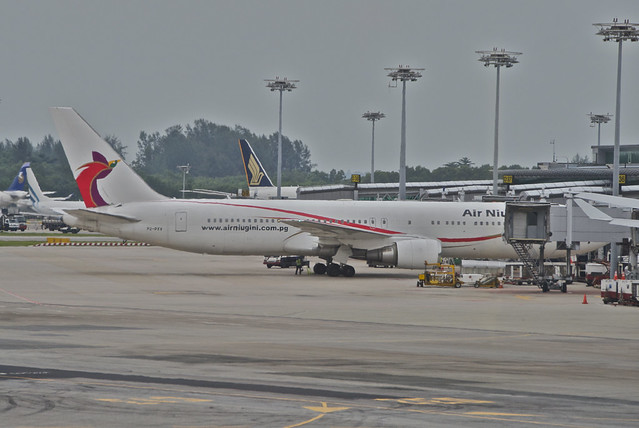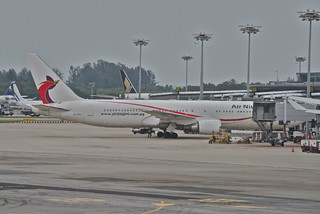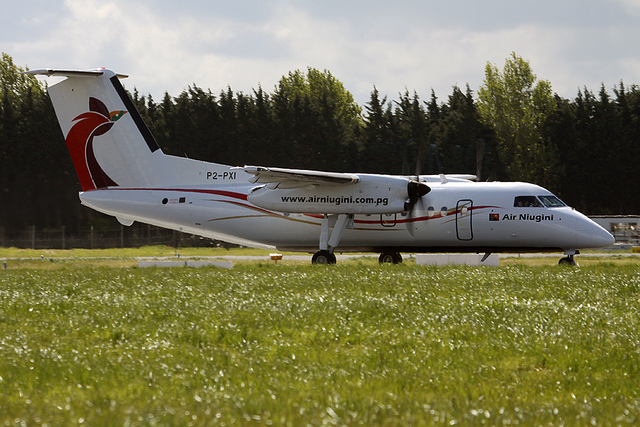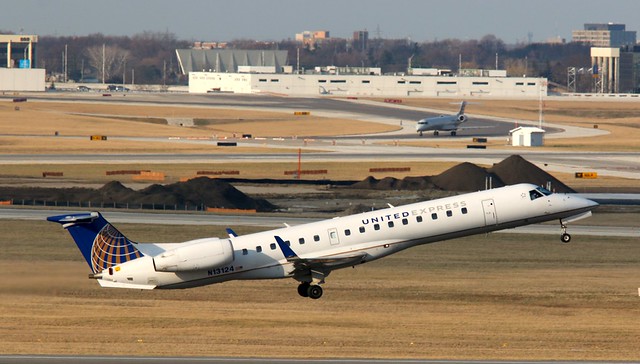Niugini F70 near Port Moresby on Nov 21st 2019, loss of cabin pressure
Last Update: March 18, 2021 / 12:32:19 GMT/Zulu time
Incident Facts
Date of incident
Nov 21, 2019
Classification
Incident
Cause
Loss of cabin pressure
Airline
Air Niugini
Flight number
PX-207
Departure
Tokua, Papua New Guinea
Destination
Port Moresby, Papua New Guinea
Aircraft Registration
P2-ANY
Aircraft Type
Fokker 70
ICAO Type Designator
F70
On Dec 17th 2019 PNG's Accident Investigation Commission (PNGAIC) opened a safety investigation into the occurrence.
On Mar 18th 2021 the PNGAIC released their final report concluding the probable cause of the serious incident was:
The defect in the Pressure Control System.
Other factors
Maintenance work had commenced on the aircraft resulting in evidence being tampered with, before AIC commenced their onsite activities.
The flight crew did not establish communication with cabin crew using the appropriate method, nor did they switch on the fasten seatbelt/no smoking sign, or set the transponder to 7700 as required by the Emergency Descent checklist, at the appropriate time.
During the emergency, the SCC assisted the child in seat 4G when she was required to be secured in her seat. The investigation determined that in an event of severe rapid depressurisation, the SCC would have been exposed to more risks.
The AIB reported the first officer (31, ATPL, 5,700 hours total, 750 hours on type) was pilot flying, the captain (62, ATPL, 21,223 hours total, 707 hours on type) was pilot monitoring.
The AIB summarized the sequence of events:
The aircraft departed Tokua Airport at 14:20, climbed to a cruising altitude of 32,000 ft and began tracking South West towards Port Moresby.
At 15:16:30, as the flight crew commenced a normal descent to their initially cleared descent altitude of 26,000 ft, Moresby Radar instructed them to continue descending to 23,000 ft. Moresby Radar further instructed the crew to maintain 23,000 ft and call Jacksons Radar on the 125.8 MHz radio frequency.
The Flight Data Recorder (FDR) data retrieved during the investigation indicated that at 15:20:44, as the aircraft was passing 23,600 ft, the Master Caution4 (MC) alert activated. The flight crew confirmed during interview, that they then noticed a cabin pressurisation controller fault message on the Multifunction Display Unit (MFDU). The investigation determined that the fault observed and referred to by the crew was the ‘CAB PRESS CTL’ fault message.
The crew stated that the MFDU also displayed instructions, identical to the Fokker 70/100 Quick Reference Handbook (QRH) ‘Cabin Pressurization Control Fault’ checklist (see Appendix A, 5.1.2). They completed this checklist at 15:21:02. The second (last) action item required them to refer to and apply the ‘Manual Cabin Pressure Control Procedure’ checklist (see Appendix A, 5.1.3).
The copilot stated in his interview that a few seconds after receiving the ‘CAB PRESS CTL’ fault message, he observed the cabin rate of change indicator showing a cabin altitude increase rate of over 4,000 FPM. However, according to the Fokker Aircraft Operating Manual (AOM), the scale on the rate of change indicator, shows a maximum of 2,000 FPM increase/decrease rate.
At 15:21:04, while levelling off at 23,000 ft, Jacksons Radar called to establish contact with the crew. The crew concurrently received an ‘Excessive Cabin Altitude’ warning along with the Master Warning (MW) alert (15:21:06). The copilot responded to Jackson Radar and asked them to standby, and about 10 seconds later called again stating that they required further descent.
The crew subsequently commenced the QRH ‘Excessive Cabin Altitude’ emergency checklist (see Appendix A, 5.1.3) of which the first item required them to don their oxygen masks. The crew stated that this checklist was actioned from memory.
At 15:21:30, Jacksons Radar instructed P2-ANY to commence descent to 11,000 ft, not below the DME steps with no speed restrictions and to expect a visual approach for runway 14L. The crew initiated the descent and maintained a descent rate of about 3,500 ft per minute. As the aircraft passed 22,000 ft the crew commenced and actioned the memory items of the QRH ‘Emergency Descent’ checklist (Appendix A, 5.1.3).
The cabin crew stated during interview, that as the aircraft was descending, they started experiencing discomfort in their ears. The cabin crew 2 (CC2) reported that she was walking through cabin, making preparations for arrival when she started observing some passengers with their hands over their ears. She added that the cabin suddenly became very cold, and she could hear the sound of what she believed was air rushing out from the air vents. She immediately walked up to the senior cabin crew (SCC), at the forward crew station and informed her about her observations. While in discussion, they began hearing the sound of breathing through oxygen masks, coming from the cockpit. They immediately returned to their respective cabin crew stations and secured themselves in their seats. The CC2 stated that as she was walking through the cabin towards her seat, she observed that the seatbelt sign was not illuminated.
At 15:23:26, while passing 19,000 ft the flight crew manually activated passenger oxygen masks and the PIC subsequently, made a public announcement (PA) instructing the passengers and cabin crew to acquire oxygen masks.
At 15:23:45, while passing 18,000 ft, the PIC broadcast a PAN, reporting that they had a cabin pressure problem and requested for a radar monitored descent to 10,000 ft. Jackson Radar immediately gave a descent clearance of 10,000 ft to P2-ANY. The crew continued the emergency descent to the cleared altitude.
Air Traffic Control (ATC) recordings showed that Jacksons Radar declared a Distress Phase (DETRESFA), at 15:25:02.
When the aircraft reached 10,000 ft, the flight crew levelled off and the pressure began to normalise (equalise with the ambient pressure). The PIC called Jacksons Radar and advised that they were visual, maintaining 10,000 ft and requested a visual approach. Jacksons Radar then instructed the crew to conduct the visual approach and asked the PIC if he preferred to track for left base or an overfly. The PIC acknowledged the visual approach and opted for an overfly.
The crew removed their oxygen masks and commenced a shallow descent to establish the aircraft on its approach path. The copilot called Jacksons Radar and reported that they were visual and they would overfly for a wide right down wind.
CVR data showed that at 15:27:43, as they continued the descent, the flight crew referred to the QRH ‘Manual Depressurisation Procedure (see Appendix A, 5.1.4), and completed checklist items that were required to be done before 9,000 ft, and waited for the cabin altitude to reach 9,000 ft.
FDR data indicated that at 15:27:53, the excessive cabin fault warning automatically terminated indicating that the cabin pressure had equalised with ambient pressure (below 10,000 ft).
At 15:28:10, when the cabin altitude reached 9,000 ft and the pressure differential dropped below 1 psi, the flight crew switched the seatbelt/no smoking sign on as required by the QRH ‘Manual Depressurisation Procedure. The PIC called the SCC and asked if the oxygen masks had deployed and she confirmed that the masks did deploy. The PIC then provided a briefing and advised the SCC to carry out her follow up duties. He then made a PA to passengers and briefly explained the emergency event that they had experienced, and informed them that a gradual descent and normal landing was expected.
As the crew continued the descent, the PIC reverted to the QRH ‘Excessive cabin altitude’ checklist and subsequently referred to the ‘Emergency descent’ checklists, and realised that they had not actioned the item to set the transponder as required, which for this case was 7700 (see Appendix A, 5.1.5).
At 15:31:07, Jacksons Radar called P2-ANY and requested for a status update. The copilot advised Jacksons Radar that they had a depressurisation and were currently unpressurised, passing 7,500 ft overhead and required 30 track miles to descend unpressurised. Jackson Radar instructed P2-ANY to descend towards the South West of the aerodrome and advise when they would be ready to turn inbound for landing. The copilot requested vectors for an instrument landing system (ILS) for runway 14L. Jacksons Radar cleared P2-ANY for the ILS approach and a descent to 2,500 ft.
At 15:34:05, while passing 7,000 ft the SCC reported to the PIC that the cabin was secured for landing. The PIC subsequently made a PA and advised the passengers that a normal approach and landing was imminent.
The crew subsequently received a clearance from Jacksons Radar for the ILS approach for runway 14L. At 15:42:50, about 10 nm North West of Jacksons, the PIC called and advised Jacksons Tower that they were established on the ILS for runway 14L, and confirmed that they were expecting a normal approach and landing.
The flight crew continued the approach and at 15:47:33, landed on runway 14L. After landing, the flight crew vacated runway and taxied to the parking bay, where all passengers and crew were reported to have disembarked safely.
The AIC analysed:
The investigation determined that there were no issues with the aircraft and its systems apart from the defect in the pressure control system. ...
Flight operations
Besides the procedural error of the flight crew by not referring to the Manual Cabin Pressurization checklist when requested by the second action item of the Cabin Pressurization Control Fault checklist, the investigation also found that during the emergency descent, the flight crew only actioned the memory items of the Emergency Descent checklist, but they did not go through the non-memory items during that manoeuvre. However, some of the non-memory items of the Emergency Descent checklist were activated when executing the Excessive Cabin Altitude checklist. No readout or confirmation of the Emergency Descent checklist was done until about 10 minutes later when, according to the CVR data, the flight crew reviewed the checklist.
Therefore, a number of action items from the Emergency Descent checklist were not actioned at the appropriate times and circumstances. These included turning the ‘seatbelt sign/no smoking sign’ on, ‘notifying ATC’, and setting the ‘transponder’ squawk code.
The crew were heard referring to the checklist after completing the emergency descent, however, the checklist is intended to be actioned when an emergency descent is decided by the crew.
The checklist required the seat belt/no smoking sign to be turned on. This is to command and ensure cabin occupants remain seated with their seatbelts securely fastened to avoiding injury during the rapid descent phase which in this case reached a rate of descent of about 7,000 ft/min.
A notification to ATC provides them with the proper information to commence appropriate coordination to assist during emergencies and also alert the appropriate authorities to allow preparations to be made at the earliest for rescue firefighting and medical assistance. Furthermore, it would alert other aircraft on the same radio frequency about the emergency, and ground preparation and coordination of the emergency.
The checklist also required the transponder to be set to the appropriate squawk code which, under those circumstances, would have been 7700 signifying an emergency. This is intended to ensure appropriate authorities are aware that an emergency situation exists and appropriate preparations are made on the ground to assist the aircraft in distress.
The investigation found that even when the emergency started at about 23,600 ft, and the aircraft entered an emergency descent, the flight crew only made a PAN call when the aircraft was passing through 18,000 ft.
Additionally, the copilot stated in his interview that a few seconds after receiving the fault message, he observed an increase rate of over 4,000 FPM in the cabin rate of change indicator. However, such an indication is out of the scale of the gauge, according to the Fokker Aircraft Operating Manual (AOM), which allows for a maximum of 2,000 FPM of increase/decrease rate. Therefore, the inaccurate indication referred by the copilot could have been as a result of him misreading or misinterpreting the information from the gauge, or due to an erroneous recollection of the information during the interview.
Cabin Emergency warning system
As provided in their emergency procedures, the cabin crew should have had to receive a pre-recorded emergency PA or the rapid decompression emergency PA from the flight crew to become aware of the situation and the appropriate actions to take. However, neither PA eventuated. The cabin crew, therefore, were unaware of the emergency situation.
The investigation found that the aircraft was not fitted with the pre-recorded tape capable of announcing the emergency. The Operator’s Safety and Emergency Procedures Manual (SEPM), Volume 1, Section 5.5.3 states that, if a pre-recorded tape is not fitted, the Pilot Monitoring or designated flight crew should make the PA announcement. Originally, there was a pre-recorded tape installed. However, since the implementation of the Manufacturers Service Bulletin SBF100-23-045 App.04, the tape was replaced with a solid-state digital music reproducer, which is not capable of announcing the emergency in the cabin.
The information in the AOM related to the automated pre-recorded tape was not up-to-date. This has the potential to present a false sense of security to pilots. Pilots may, due to workloads associated with emergencies, rely on automated systems to take care of certain tasks without knowing that the system is no longer available.
The earliest PA the investigation found was at the point where the oxygen masks were deployed, after the aircraft had already descended about 5,000 ft under emergency conditions, telling passengers and cabin crew to acquire oxygen. The investigation determined that the general flight crew communication with cabin crew were not consistent with the Operator’s emergency communication requirements and the rapid depressurisation procedures.
Air traffic control
The depressurisation occurred during the approach into Jacksons Airport and ATC facilitated the crews’ requests without delay.
Upon the crews request for further descent, ATC instructed them to conduct a normal descent with a restriction from going below the DME steps. The investigation found that the normal descent instruction was issued because at that time, ATC was not aware of the pilots’ intentions for an emergency descent.
ATC was only made aware of the emergency situation by the crew when, about two minutes after the above referred clearance, the flight crew broadcast a PAN call, while passing through 17,000 ft. Immediately following the PAN call, ATC declared a Distress Phase. The Aerodrome Emergency Procedures were activated by ATC, and the Aviation Rescue Fire Fighting services were advised to stand by at taxiway golf. On final approach at 10 miles, the pilot advised the tower that they were expecting a normal approach and landing. After the aircraft touched down safely, the ARFF were advised to stand down their services.
Cabin Pressure Control System
The cabin pressure control system fault was first observed and reported by the flight crew on 19 November 2019. The Cabin Pressure Controller was checked by the Operator’s engineers and found faulty. Subsequently, the CPC was replaced and tested and found to be serviceable. It was believed that the defect had been rectified so the aircraft was then released back to service on the same day.
However, the same fault was observed again during a flight on 20 November 2019, the next day. The engineers carried out an operational check on the outflow valve and the results, to them, were satisfactory. After replacing the air filter, the fault did not appear to exist anymore. The aircraft was therefore, released back to service.
On 21 November 2019, the same fault was observed a third time, and on this occasion, a rapid depressurisation occurred along with an associated warning activation. An emergency descent was conducted from 23,000 ft to 10,000 ft as a result.
The investigation determined that the defect associated with the depressurisation event was probably the same defect that caused the fault activations in the two preceding days. The defect was never identified and rectified before the occurrence flight. The investigation believes that the system may have either been malfunctioning intermittently or, the flight conditions simulated on the ground during maintenance may not have been representative of the actual flight conditions resulting in false readings being received by the engineers.
The investigation was unable to conclusively determine the cause of the cabin pressure control system fault due to the post occurrence troubleshooting and maintenance action errors, which resulted in difficulty to narrow the fault identification.
The investigation determined that this kind of inadequate maintenance practice may have also contributed to the misdiagnosis which occurred during maintenance prior to the occurrence.
Survivability aspects
The investigation determined that the cabin crew initiated and actioned their decompression drill actions in a timely manner due to the fact that they were in the forward crew station when they heard what they believed to be the sound of flight crew breathing through their oxygen masks. This was following the initial observations they made including; discomfort in their ears, rushing air from the air vents and cabin suddenly becoming very cold.
According to their safety emergency procedures, the SCC was required to remain in her seat until the aircraft had reached a safer altitude and the PIC had made a PA for cabin crew to carry out their follow up duties, however she still assisted the child at seat 4G with his oxygen mask. Although this action was taken before the emergency descent, it is vital for the Cabin Crew to be secured in their seats during the emergency phase to ensure that they are safe in order to assist and care for passengers, post emergency.
The investigation determined that had the child been seated next to an adult or closer to his family, the SCC would not feel obliged to leave her seat to assist the child during the emergency phase.
Incident Facts
Date of incident
Nov 21, 2019
Classification
Incident
Cause
Loss of cabin pressure
Airline
Air Niugini
Flight number
PX-207
Departure
Tokua, Papua New Guinea
Destination
Port Moresby, Papua New Guinea
Aircraft Registration
P2-ANY
Aircraft Type
Fokker 70
ICAO Type Designator
F70
This article is published under license from Avherald.com. © of text by Avherald.com.
Article source
You can read 2 more free articles without a subscription.
Subscribe now and continue reading without any limits!
Read unlimited articles and receive our daily update briefing. Gain better insights into what is happening in commercial aviation safety.
Send tip
Support AeroInside by sending a small tip amount.
Related articles
Niugini B763 over Pacific on Apr 9th 2025, cracked windshield
An Air Niugini Boeing 767-300, registration P2-PXV performing flight PX-3 from Port Moresby (Papua New Guinea) to Brisbane,QL (Australia), was…
Niugini F70 at Port Moresby on Feb 20th 2023, loss of cabin pressure
An Air Niugini Fokker 70, registration P2-ANT performing flight PX-188 from Port Moresby to Mount Hagen (Papua New Guinea) with 67 passengers and 4…
Niugini B763 at Port Moresby on Mar 22nd 2022, cabin did not pressurize
An Air Niugini Boeing 767-300, registration P2-PXV performing flight PX-3 from Port Moresby (Papua New Guinea) to Brisbane,QL (Australia), was…
Niugini F100 near Madang on Mar 18th 2020, loss of cabin pressure
An Air Niugini Fokker 100, registration P2-ANF performing flight PX-121 from Wewak to Port Moresby (Papua New Guinea) with 43 passengers and 5 crew,…
Niugini DH8B near Yuzhno-Sakhalinsk on Dec 20th 2020, technical malfunction
An Air Niugini de Havilland Dash 8-200 in completely white paintscheme with no company logo, registration P2-PXI performing a positioning flight from…
Newest articles
The GPS Problem No One Wants to Discuss in 2026
GPS is widely perceived as a solved problem. It works, it’s global, and it underpins everything from smartphones to financial systems. Yet in…
Commute ERJ145 at Washington on Jan 12th 2026, engine shut down in flight
A Commute Air Embraer ERJ-145 on behalf of United, registration N13124 performing flight UA-4295 from Washington Dulles,DC to Mobile,AL (USA) with 43…
Subscribe today
Are you researching aviation incidents? Get access to AeroInside Insights, unlimited read access and receive the daily newsletter.
Pick your plan and subscribePartner

ELITE Simulation Solutions is a leading global provider of Flight Simulation Training Devices, IFR training software as well as flight controls and related services. Find out more.
SafetyScan Pro provides streamlined access to thousands of aviation accident reports. Tailored for your safety management efforts. Book your demo today
AeroInside Blog
Popular aircraft
Airbus A320Boeing 737-800
Boeing 737-800 MAX
Popular airlines
American AirlinesUnited
Delta
Air Canada
Lufthansa
British Airways





